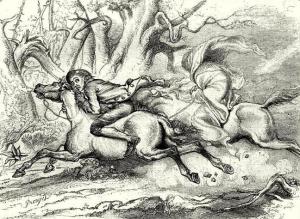It is difficult to say how an idea might grab you.I really have no idea why Washington Irving’s “The Legend of Sleepy Hollow” took my childhood imagination prisoner and has kept it stoutly locked up over all these years.Perhaps it was the Disney version seen as a child that left me with shivers of wonder akin to a species of joy.The autumnal setting, the implied ghost, the ambiguity of the final scene.I used to be as avid a philatelist as one can be in a small town, and the Sleepy Hollow stamp of 1974 held me transfixed long before I ever encountered Tim Burton’s vision of the legend.After having watched the silent Headless Horseman a couple of times, I went back to The Sketch Book of Geoffrey Crayon, Gent., and read the original again.This time I followed it up with the appendix in my edition, written a decade or two after the story by an older Irving.

The 1922 movie runs fairly close to the literary original (for the most part), especially when you add the appendix.The appendix (in the edition I have—The Modern Library, 2001) is an essay titled “Sleepy Hollow.”It reflects on Irving’s recollections of what Sleepy Hollow was like in his youth (he returned to the area to settle later in life).The village church, which features in “The Legend,” provides a source of much of his reverie and this is incorporated into the early cinematic version as well, in the Sunday morning scene.I also noticed how frequently psalmody enters the original story.The tale does not mention the Bible, but psalmody was an early form of church music, and “The Legend” has Ichabod use it when he’s afraid as well as for teaching students to sing, for a few shiny shillings.
Washington Irving is sometimes credited with the invention of the short story as a literary form. His younger contemporary Edgar Allan Poe worked in that format, and the two of them contended with making a living (the former more successfully) purely as literary writers.Irving’s spooky tales, however, often have something of the comic about them.His story-telling style uses folksy, folkloric exaggeration and humor to prevent it from becoming too dark.Poe would snuff the candle and let the fear be unhindered.I knew of Sleepy Hollow before I discovered Poe, and this recent resurgence is perhaps a way of exploring my own literary roots.It’s nearly half-way through September already, and Tarrytown beckons.
